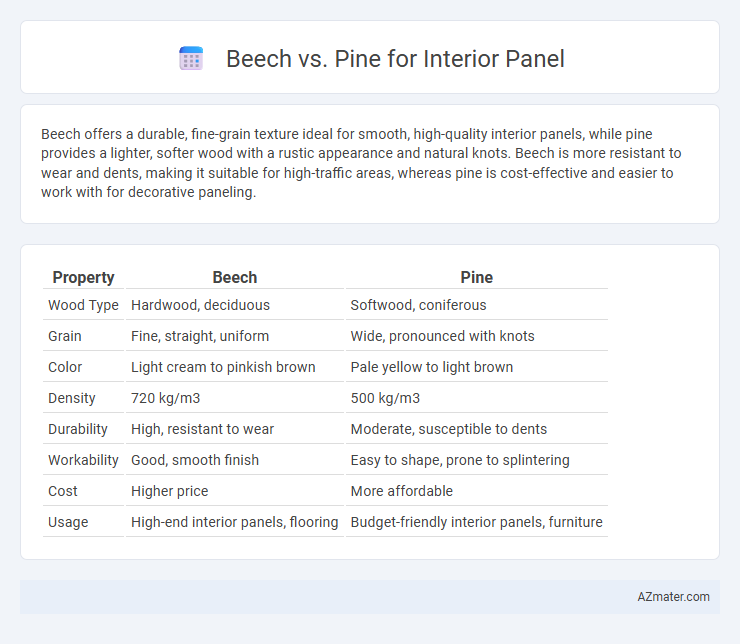Beech offers a durable, fine-grain texture ideal for smooth, high-quality interior panels, while pine provides a lighter, softer wood with a rustic appearance and natural knots. Beech is more resistant to wear and dents, making it suitable for high-traffic areas, whereas pine is cost-effective and easier to work with for decorative paneling.
Table of Comparison
| Property | Beech | Pine |
|---|---|---|
| Wood Type | Hardwood, deciduous | Softwood, coniferous |
| Grain | Fine, straight, uniform | Wide, pronounced with knots |
| Color | Light cream to pinkish brown | Pale yellow to light brown |
| Density | 720 kg/m3 | 500 kg/m3 |
| Durability | High, resistant to wear | Moderate, susceptible to dents |
| Workability | Good, smooth finish | Easy to shape, prone to splintering |
| Cost | Higher price | More affordable |
| Usage | High-end interior panels, flooring | Budget-friendly interior panels, furniture |
Introduction to Beech and Pine as Interior Panel Options
Beech and pine are popular wood choices for interior paneling, each offering unique characteristics suited for different design aesthetics. Beech features a smooth texture, fine grain, and light color, making it ideal for modern, clean interior designs that require durability and resistance to wear. Pine, known for its soft grain, warmth, and knots, is favored for rustic or traditional interiors, providing an affordable and versatile option with easy workability and natural charm.
Physical Appearance and Color Differences
Beech interior panels exhibit a fine, uniform grain with a smooth texture and a warm, pale cream to light reddish-brown color that deepens naturally over time. Pine panels feature a more pronounced grain pattern with visible knots and a lighter yellowish to pale amber hue that can darken to a rich golden tone as it ages. The distinct contrast in grain tightness and color stability makes beech ideal for sleek, modern interiors, while pine suits rustic or country-style designs.
Grain Patterns and Texture Comparison
Beech interior panels exhibit a fine, tight grain with a smooth texture, offering a uniform and consistent appearance that enhances modern and minimalist designs. Pine panels feature a more pronounced and varied grain pattern, with visible knots and a softer texture that adds warmth and rustic charm to interiors. The choice between beech and pine for interior paneling depends on whether a sleek, refined look or a natural, textured aesthetic is desired.
Durability and Strength of Beech vs Pine
Beech wood is renowned for its exceptional durability and strength, making it ideal for interior paneling that requires long-lasting performance. Compared to pine, beech has a higher density and hardness, offering greater resistance to wear, dents, and impacts. Pine, being softer and less dense, is more prone to scratches and damage, which may require more frequent maintenance in high-traffic interior environments.
Workability and Ease of Installation
Beech offers superior workability due to its fine, even grain and hardness, allowing for smooth sanding and precise cuts ideal for intricate interior panel designs. Pine is softer and lighter, making it easier to handle and install, but it dents more easily and may require more care to avoid damage during fitting. Both woods are popular for interior panels, but Beech provides a more durable finish, while Pine offers cost-effective and user-friendly installation.
Cost Comparison: Beech vs Pine
Beech interior panels generally cost more than pine due to their higher density and durability, making them a premium choice for long-lasting applications. Pine is more affordable, widely available, and easier to work with, offering a budget-friendly option for interior paneling. The choice between beech and pine ultimately balances upfront costs against the desired longevity and aesthetic finish of the interior space.
Environmental Impact and Sustainability
Beech wood is a renewable resource with a relatively fast growth rate, making it a sustainable choice for interior panels, while its dense grain contributes to long-lasting durability and reduced need for replacement. Pine, sourced from sustainably managed forests, typically has a lower environmental footprint due to quicker maturity cycles and efficient carbon sequestration. Both woods offer environmentally friendly options, but choosing certified sources such as FSC-certified Beech or Pine panels greatly enhances sustainability by ensuring responsible forest management and reduced ecosystem disruption.
Maintenance and Longevity Considerations
Beech wood offers superior durability and resistance to wear, making it ideal for high-traffic interior panels that require minimal maintenance over time. Pine, being softer and more prone to dents and scratches, demands more frequent upkeep and refinishing to maintain its appearance. Choosing Beech ensures longer-lasting paneling with less maintenance effort, while Pine provides a budget-friendly option with higher maintenance demands.
Best Applications for Beech and Pine Panels
Beech panels are ideal for interior applications requiring durability and a fine, smooth finish, such as high-end furniture, cabinetry, and flooring, thanks to their dense grain and resistance to wear. Pine panels excel in applications where cost-effectiveness and ease of workability are prioritized, including wall paneling, ceiling boards, and decorative moldings, due to their softer texture and natural light color. Both woods offer unique aesthetic qualities, with beech providing a uniform, reddish-brown hue and pine lending a rustic, warm appearance with distinct knots.
Conclusion: Choosing the Right Wood for Your Interior Panel
Beech offers a smooth, fine grain and hardness that ensures durability and a refined appearance, making it ideal for high-traffic interior panels. Pine provides a softer, lighter texture with natural knots, creating a rustic, warm aesthetic suitable for casual or country-style interiors. Selecting between Beech and Pine depends on your preference for durability versus rustic charm and the specific design style of your space.

Infographic: Beech vs Pine for Interior Panel
 azmater.com
azmater.com